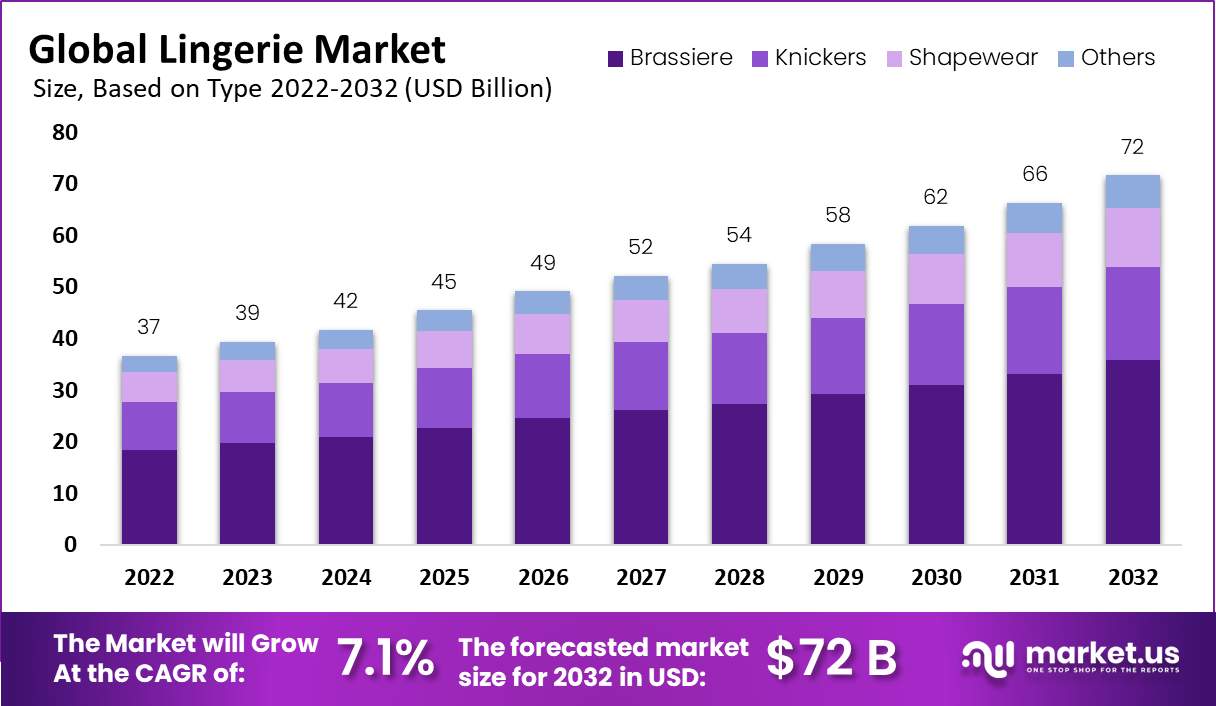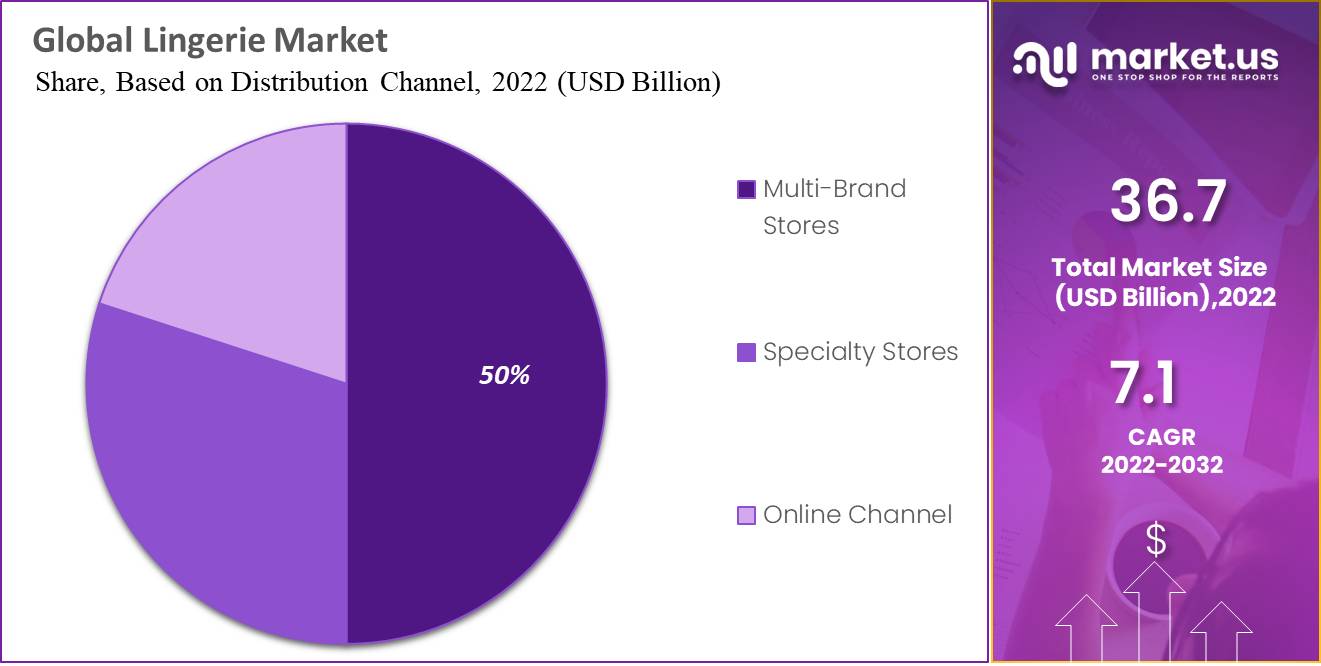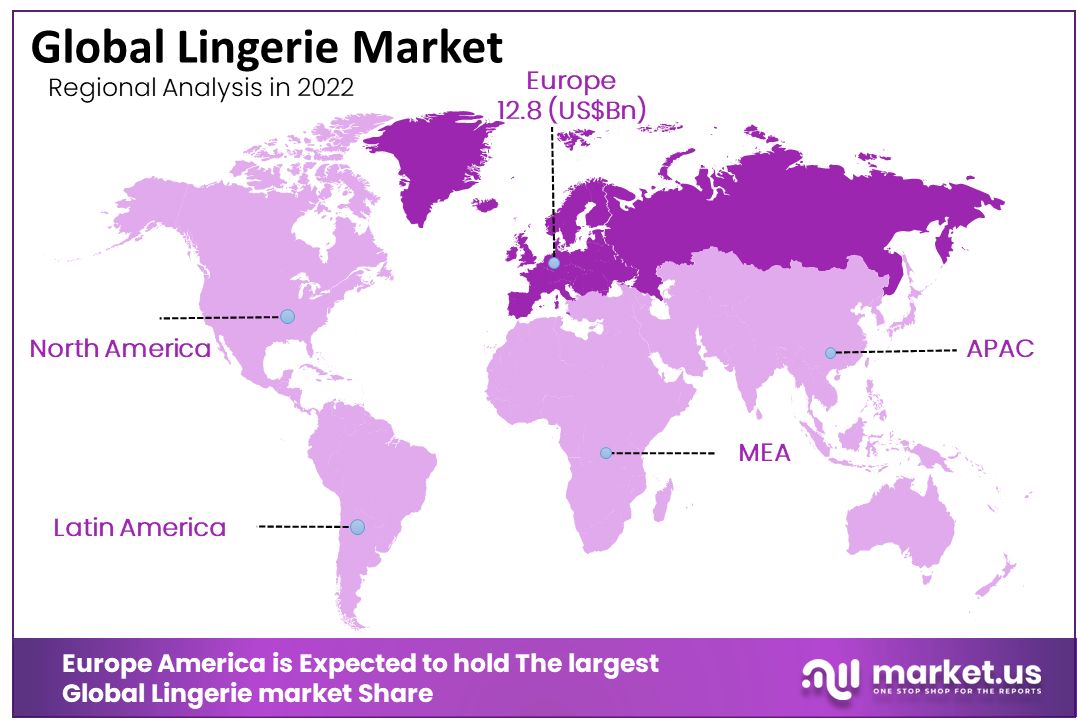Global Lingerie Market By Type (Brassiere, Knickers, Shapewear, and Others), By Distribution Channel (Specialty Stores, Multi Brands Stores, and Online Channels), By Region and Companies - Industry Segment Outlook, Market Assessment, Competition Scenario, Trends, and Forecast 2023-2032
- Published date: Sep 2023
- Report ID: 20788
- Number of Pages: 297
- Format:
- keyboard_arrow_up
Quick Navigation
Report Overview
The Global Lingerie Market size is expected to be worth around USD 72.9 Billion by 2032 from USD 36.70 Billion in 2022, growing at a CAGR of 7.10% during the forecast period from 2023 to 2032.
Market growth is expected to be driven by a growing awareness of the latest fashion and an ever-increasing number of women with higher spending power. The increasing availability of multiple products also drives this global market in various styles, such as sports, bridal, and regular wear.
The growing popularity of products and variety of purchase options is also one of the key factors attributed to the increasing desire among women to enhance their natural beauty.

Driving Factors
Increasing Concerns About Flexible Fabrics
Concerns about the use of flexible fabric in lingerie are driving this market. Due to the increasing popularity of these products, the market size continues to grow. Lingerie Market growth is expected to be caused by lingerie designers who are focusing on creating products with lace and embroidery, luxurious materials, brighter colors, and other appealing features.
Manufacturers are also introducing trendy lingerie that can be worn for different activities, as consumers tend to favor color and fabric. Jockey has a large selection of nursing and sports bras.
Competitive Landscape and Focus of Consumers on Comfort and Style.
This global lingerie market is experiencing a surge in demand for seamless, one-piece intimate apparel with a natural look. Jockey and Enamor offer seamless briefs and briefs from manufacturers like Amante and Hunkemoller. A wide range of colors, finish applications, and fabric designs contribute to the shift in consumer behavior concerning lingerie.
Research and development is a primary focus of companies. The demand for lingerie is driven by the need for outerwear that women can wear and a focus on comfort and style. Parfait, a US-based company, introduced plus-sized intimate clothing in India in 2022 with high quality, fit, and comfort. Women’s Secret, a Spanish brand, opened retail stores in India. It intends to extend its reach in Delhi and East & South India.
Restraining Factors
Increasing Product Prices Over Time.
Due to changing fashion trends and constant changes in tastes and customer expectations, prices in the lingerie market have increased over time. As a result, the market’s production costs have risen, negatively impacting the global lingerie market.
Growth Opportunities
Growing Environmental Awareness and Eco-Friendly Production
The emergence of sustainable product variations acts as an essential growth factor. Brands and leading companies are adopting eco-friendly production processes and using biodegradable materials to produce eco-friendly lingerie sets. It is becoming increasingly popular mainly due to the growing environmental awareness of the masses.
Easy product availability through fast-growing online platforms, attractive discounts, affordable price points for leading brands, special offers, and other factors, such as consumer urbanization and increasing spending power in developing regions, continue to create a positive outlook for the market.
Latest Trends
Globalization and Rapid Development of Information Technologies Boosting the Market.
One of the primary growth factors is the increasing preference of consumers for the latest fashion trends ranging from loungewear to intimate wear. Globalization and the rapid development of information technology are providing information on the market’s most current and popular products.
Many customers now prefer to shop online for products to save time and choose from a wide variety of lingerie collections. Market players are taking advantage of this opportunity and offering their effects on the Internet while increasing their customer base.
Sustainable product options are the latest growth drivers. In recent years, the lingerie market size has changed dramatically. As consumers become more environmentally conscious, they aim to purchase lingerie made from sustainable fabrics.
Hence brands of all sizes are taking initiatives to become more ecologically and socially responsible. Many brands look forward to addressing challenges such as sourcing materials and adopting a circular economic model. This is a significant change in the market.
Type Analysis
Brassiere Segment Commanded the Largest Market Share
By type, the global lingerie market is segmented into brassiere, knickers, shapewear, and others. The Brassiere segment commanded the major market share in 2022. The availability of new fabrics and the constant technological evolution have allowed designers to innovate and retain their market size and leadership. With multiple sizes and precise cuts, innovations such as model, leaser, and full
The Knickers segment is projected to grow at an 8.1% annual growth rate over the forecast period. Manufacturers are increasingly focusing on producing knickers from comfortable fabrics like cotton and nylon. Lingerie can be made in various styles, including full-length, hipster, and shorts. Companies are developing special knickers, including lacy designs, jacquard, no VPL-lace trim, and high-waisted controls to offer comfort and other benefits.
Distribution Channel Analysis
Multi-Brands Stores Segment Holds Largest Market Share
By distribution channels, the market is classified into specialty stores, multi-brand stores, and online. According to distribution channels, the multi-brand store segment accounted for the largest market for lingerie market growth in 2022. The primary factor for segment popularity is its many benefits, such as the possibility to scan products before buying and the trial option. A store associate can also help consumers select the right product from a range of bras, which helps boost this segment’s growth.
Lingerie products are distributed by major retailers such as Shoppers Stop and H&M. Clovia, Zivame, and other companies that have expanded their offline segments. Clovia operates 13 brand outlets and 150 retail touchpoints like Central and Brand Factory. Zivame can also be found in 800 multi-brand outlets, such as Shoppers Stop. Over the forecast period, the ‘Online’ distribution channel segment is expected to grow at a 7.8% annual rate.
Companies have begun to tie up with online retailers to reach the most comprehensive consumer base and introduce e-portals, such as Myntra. Some companies have online portals, such as Zivame.com, Jockeyinternational.com, Victoriasecret.com, Clovia.com, and hunkemoller.com. To distribute their lingerie products, two of the most prominent brands, MAE and Arabelle, teamed up with Amazon.

Key Market Segments:
Based on Type
- Brassiere
- Knickers
- Shapewear
- Others
Based on the Distribution Channel
- Specialty Stores
- Multi-Brand Stores
- Online Channel
COVID-19 Impact Analysis
Reduced Demand for Products and Sales During COVID-19
During the COVID-19 pandemic, the lingerie market growth was hit very hard, resulting in reduced demand and sales. Consumers started opting for e-commerce and online platforms due to the shutdown of retail outlets by the government because of the lockdown. The pandemic forced significant market players to sell their products online to stay relevant in the competitive landscape.
Regional Analysis
Europe Having Highest Market Size
Europe is the regional market with the highest share of over 35.0%. The presence of well-established players and the increased demand for premium and luxury brands are significant drivers of this market. Companies emphasize the importance of designing and quality for every shape and size. The high preference for good lingerie brands and limited editions in Europe has aided global market growth. Regional market growth is being driven by increased product availability and the penetration of offline and online channels.
Asia Pacific is expected to be the fastest-growing regional market, with a high CAGR over the forecast period. The key industry trends include Increasing awareness of best-fits by usage, variety of fabrics, changing lifestyles of working millennials, increasing disposable incomes, and an obsession with maintaining a clean structure/silhouette.
Consumers are open to spending more on innovative products to purchase lingerie. International companies are opening stores in this region to reach more customers. La Perla, an Italian luxury lingerie brand, opened its Indian stores. Similarly, Etam, a French lingerie brand, formed a joint venture with Future Group to expand its customer base.

Key Regions and Countries:
- North America
- The US
- Canada
- Mexico
- Western Europe
- Germany
- France
- The UK
- Spain
- Italy
- Portugal
- Ireland
- Austria
- Switzerland
- Benelux
- Nordic
- Rest of Western Europe
- Eastern Europe
- Russia
- Poland
- The Czech Republic
- Greece
- Rest of Eastern Europe
- APAC
- China
- Japan
- South Korea
- India
- Australia & New Zealand
- Indonesia
- Malaysia
- Philippines
- Singapore
- Thailand
- Vietnam
- Rest of APAC
- Latin America
- Brazil
- Colombia
- Chile
- Argentina
- Costa Rica
- Rest of Latin America
- Middle East & Africa
- Algeria
- Egypt
- Israel
- Kuwait
- Nigeria
- Saudi Arabia
- South Africa
- Turkey
- United Arab Emirates
- Rest of MEA
Strategic initiatives such as mergers or acquisitions by major players are boosting market growth. For Instance, HanesBrands acquired Bras N Things in 2022 to expand its millennial customer base via online distribution. Naked Brand Group Inc. also merged with Bandon Limited in 2022 to further expand its global business and regional presence.
Emerging key market players are focused on various strategic policies to develop their respective businesses in the foreign lingerie market. Several lingerie market companies are concentrating on expanding their existing operations and R&D facilities. Furthermore, firms in the lingerie market are developing new products and portfolio expansion strategies through investments, mergers, and acquisitions. In addition, several key players are now focusing on marketing strategies.
Top Key Players in the Lingerie Market:
Listed below are some of the most prominent global lingerie market players.
- Jockey International Inc.
- Zivame
- Victoria’s Secret
- Hanesbrands Inc.
- Gap Inc.
- Hunkemoller
- Triumph International Ltd.
- Calvin Klein
- Fashion Nova Inc.
- Other Key Players
Recent Developments:
- Fast Retailing Co., Ltd. is a listed company headquartered in Japan. A global company with revenues of US$ 19.1 Bn and approximately 55,589 employees. Income from its online lingerie market in India and other products contributes to overall revenue but is not the company’s primary source of revenue.
- In February 2022, MAS Holdings partnered with renowned digital retail store software, BeyondXR, to create a virtual showroom to enhance the retail experience. This collaboration will allow MAS to present its new collection to global brands in a virtual gallery.
Report Scope:
Report Features Description Market Value (2022) US$ 36.7 Bn Forecast Revenue (2032) US$ 72.9 Bn CAGR (2023-2032) 7.10% Base Year for Estimation 2022 Historic Period 2016-2022 Forecast Period 2023-2032 Report Coverage Revenue Forecast, Market Dynamics, COVID-19 Impact, Competitive Landscape, Recent Developments Segments Covered By Type- Brassiere, Knickers, Shapewear, and Others; By Distribution Channel- Specialty Stores, Multi-Brand Stores, and Online Channel Regional Analysis North America – The US, Canada, & Mexico; Western Europe – Germany, France, The UK, Spain, Italy, Portugal, Ireland, Austria, Switzerland, Benelux, Nordic, & Rest of Western Europe; Eastern Europe – Russia, Poland, The Czech Republic, Greece, & Rest of Eastern Europe; APAC – China, Japan, South Korea, India, Australia & New Zealand, Indonesia, Malaysia, Philippines, Singapore, Thailand, Vietnam, & Rest of APAC; Latin America – Brazil, Colombia, Chile, Argentina, Costa Rica, & Rest of Latin America; the Middle East & Africa – Algeria, Egypt, Israel, Kuwait, Nigeria, Saudi Arabia, South Africa, Turkey, United Arab Emirates, & Rest of MEA Competitive Landscape Jockey International Inc., Zivame, Victoria’s Secret, Hanesbrands Inc., Gap Inc., Hunkemoller, Triumph International Ltd., Calvin Klein, Fashion Nova Inc., and Other Key Players. Customization Scope Customization for segments, region/country-level will be provided. Moreover, additional customization can be done based on the requirements. Purchase Options We have three licenses to opt for Single User License, Multi-User License (Up to 5 Users), Corporate Use License (Unlimited User and Printable PDF) Frequently Asked Questions (FAQ)
Q. What is the lingerie market growth?The global lingerie market is expected to grow at a compound annual growth rate of 7.10% from 2022 to 2032 and is predicted to reach USD 72.9 billion by 2032.
Q. How big is the lingerie market?The global lingerie market size was estimated at USD 36.7 billion in 2022, and is expected to reach USD 72.9 billion by 2032.
Q. What segments are covered in the Global Lingerie Market report?The Global Lingerie Market is Segmented on the basis of Type, Material, Distribution Channel, and Geography.
Q. What are the key driving factors for the growth of the global Lingerie Market?The rapidly changing customer demands for attractive and innovative clothing goods are driving the global Lingerie Market during the anticipated period.

- Jockey International Inc.
- Zivame
- Victoria's Secret
- Hanesbrands Inc. Company Profile
- Gap Inc.
- Hunkemoller
- Triumph International Ltd.
- Calvin Klein
- Fashion Nova Inc.
- Other Key Players
- settingsSettings
Our Clients
| Single User $4,599 $3,499 USD / per unit save 24% | Multi User $5,999 $4,299 USD / per unit save 28% | Corporate User $7,299 $4,999 USD / per unit save 32% | |
|---|---|---|---|
| e-Access | |||
| Report Library Access | |||
| Data Set (Excel) | |||
| Company Profile Library Access | |||
| Interactive Dashboard | |||
| Free Custumization | No | up to 10 hrs work | up to 30 hrs work |
| Accessibility | 1 User | 2-5 User | Unlimited |
| Analyst Support | up to 20 hrs | up to 40 hrs | up to 50 hrs |
| Benefit | Up to 20% off on next purchase | Up to 25% off on next purchase | Up to 30% off on next purchase |
| Buy Now ($ 3,499) | Buy Now ($ 4,299) | Buy Now ($ 4,999) |












